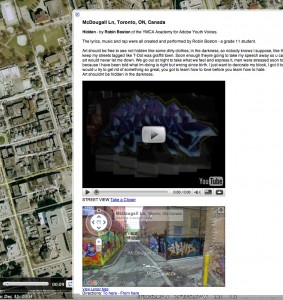This post by Toronto-based PLP community leader Peter Skillen, describing “a project that worked,” first appeared in his blog The Construction Zone in November, 2009. We’re delighted to share it here, along with a fresh reflection on the work from Peter.
by Peter Skillen
I would like to share with you the story of Hidden – a project that was developed by a student in the 11th grade under the umbrella of Adobe Youth Voices and iEARN. This project then grew naturally into a bigger project as the result of a 10th grade student.
Let me start first by showing you the video – HIDDEN – by Robin.
PhotoShop – “Creating the images”
We had been learning about the artist, David Hockney, and had practised ‘squaring off’ some images in PhotoShop using the following tutorial:
Robin then saved various layers, and combinations of layers, as jpegs for inclusion into Adobe Premiere Elements.
Adobe Youth Voices and iEARN – “Student in charge”
Adobe Youth Voices is a global philanthropic initiative to empower youth. Svetlana Yakubovskaya from Minsk, Belarus and Juan Domingo Martinez from Esquel, Argentina led a great online course with 20 or so other educators from around the globe. Then the students and I started our plans for the media projects. It was a challenge for us all to agree on a plan and we changed the plans as we moved through the process. Students finally decided to create their own media arts pieces out of their previous work in Media Arts class. All the results have been posted on the YMCA Academy YouTube channel.
 Robin believes that art should not be hidden for only people with money to see. He sees graffiti as a form of art that is available to all.
Robin believes that art should not be hidden for only people with money to see. He sees graffiti as a form of art that is available to all.
I believe his work is so successful for several reasons. This project was his. He owned it. He created the idea. He had the passion. He had the motivation. He wrote the rap. He composed the music. He performed it. He struggled with the contradictions. He overcame the ambiguities. He was in charge and maintained focus and effort until completion.
Once posted to the Adobe and iEARN websites, Sasa Sirk from Slovenia contacted me. She is a teacher who is running a graffiti project called Listen to the Walls Talking – an iEARN project. She asked if Robin would be interested in collating some of the works of other graffiti artists from the project. He agreed.
Google Earth as a Multimedia Tool – “Now it gets interesting!”
 However, Alex (10th grade) and Robin joined forces and decided to take some previous knowledge of Google Earth and produce a multimedia Google Earth tour of graffiti sites from the Listen to the Walls Talking project. Again, their idea…their initiative. Their passion. To see their results (a work in progress!), download the Graffiti.kmz file, double click it, and Google Earth will open up. (If you don’t have Google Earth resident on your hard drive, you’ll need to grab it first. It’s free.) Click on the various sites in the sidebar and then click on the placemark to see the artwork from that location. (Here’s how to do that.) In some cases, you will see ‘street view’ of that location as well. (See McDougall Lane in Toronto for an example.) Please be aware that this is a rough draft of an adventure in learning. We, by no stretch, understand the intricacies of Google Earth at this point.
However, Alex (10th grade) and Robin joined forces and decided to take some previous knowledge of Google Earth and produce a multimedia Google Earth tour of graffiti sites from the Listen to the Walls Talking project. Again, their idea…their initiative. Their passion. To see their results (a work in progress!), download the Graffiti.kmz file, double click it, and Google Earth will open up. (If you don’t have Google Earth resident on your hard drive, you’ll need to grab it first. It’s free.) Click on the various sites in the sidebar and then click on the placemark to see the artwork from that location. (Here’s how to do that.) In some cases, you will see ‘street view’ of that location as well. (See McDougall Lane in Toronto for an example.) Please be aware that this is a rough draft of an adventure in learning. We, by no stretch, understand the intricacies of Google Earth at this point.
But, as we often say here, “Just go for it! Take charge!”
PROJECT BASED LEARNING RESOURCES
A Reflection – two years later
We can all learn from ‘looking back’ on the way we did things. I, too, have learned. One of my greatest areas of weakness when doing this kind of project-based learning (PBL) is that of ‘exhibiting’ the final works.
Adobe Youth Voices emphasizes thinking in advance about how the art works will be exhibited. There are many reasons for this. After all, one of the missions is for the youth to impact the world with their creations – with their messages. I understand and respect this. But I will be very transparent about why I did not do a great job at this part. Perhaps you will relate.
My educational philosophy lies on the side of ‘process’ not ‘product’. So I often see the benefits in the creation – not in the end product. But, alas, it is not as simple as that. It is a rather naïve view. The ‘exhibit’ experience is part of great process too – the process of exhibiting your work is an art form as well. It depends on the purpose of the project, I believe.
_____________
 Peter Skillen is Manager of Professional Learning for Social Media with the YMCA of Greater Toronto after 40 years teaching students & teachers. He was a founding teacher at the YMCA Academy – a secondary school serving youth who prefer an alternative approach. Peter has been involved in technology supported, project-based learning since the late 1970s and continues to explore & develop deep applications of the latest Web 2.0 technologies – particularly as it relates to learner agency, passion, motivation and cognitive intent. He develops and supports both face-to-face and online learning for the Ontario Teachers’ Federation and is an ‘Experienced Voice’ & Community Leader with Powerful Learning Practice.
Peter Skillen is Manager of Professional Learning for Social Media with the YMCA of Greater Toronto after 40 years teaching students & teachers. He was a founding teacher at the YMCA Academy – a secondary school serving youth who prefer an alternative approach. Peter has been involved in technology supported, project-based learning since the late 1970s and continues to explore & develop deep applications of the latest Web 2.0 technologies – particularly as it relates to learner agency, passion, motivation and cognitive intent. He develops and supports both face-to-face and online learning for the Ontario Teachers’ Federation and is an ‘Experienced Voice’ & Community Leader with Powerful Learning Practice.
John Norton
Latest posts by John Norton (see all)
- I'm a "Learner First" in a Whole New World - July 1, 2013
- Hale@home: Easing Student Transitions via Online Learning - May 17, 2013
- Our Top 13 Voices Posts for 2012! - January 1, 2013


Trackbacks/Pingbacks